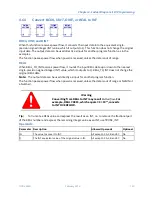
Chapter 4. Ladder Diagram (LD) Programming
110
PACSystems* RX7i, RX3i and RSTi-EP CPU Programmer's Reference Manual
GFK-2950C
Example
A UDFB is defined that uses a member variable for a Drum function block. Two instances of the
function block are created: Drum_A and Drum_B. During each logic scan, both Drum_A and Drum_B
are executed. However, only the member variable in Drum_A is updated and the member variable in
Drum_B always remains at 0.
Operands for Drum
Parameter Description
Allowed Operands Optional
????
(Control Block) The beginning address of a five-word array that
contains the Drum Sequencer's control block. The contents of
the control block are described below.
R, P, L, W, Symbolic No
??
(Length) Value between 1 and 128 that specifies the number of
steps.
Constant
No
S
Step input. Used to go one step forward in the sequence. When
the function receives power flow and S makes an OFF to ON
transition, the Drum Sequencer moves one step. When R
(Reset) is active, the function ignores S.
flow
No
R
Reset input. Used to select a specific step in the sequence.
When the DRUM function and Reset both receive power flow,
DRUM copies the Preset Step value in the Control Block to the
Active Step reference in the Control Block. Then the function
copies the value in the Preset Step reference to the Q reference
bits. When R is active, the function ignores S.
flow
No
PTN
(Pattern) The starting address of an array of words. The number
of words is specified by the Length (??) operand. Each word
represents one step of the Drum Sequencer. The value of each
word represents the desired combination of outputs for a
particular value of the Active Step word in the control block.
The first element corresponds to an Active Step value of 1; the
last element corresponds to an Active Step value of Length. The
programming software does not create an array for you. You
must ensure you have enough memory for PTN.
All except constant
and S, SA
—
SC
numerical data.
No
DT
(Dwell Time ) If you use the DT operand, you must also use the
DTO operand and vice-versa. The DT operand is the starting
address of Length words of memory, where Length is the
number of steps. Each DT word corresponds to one word of
PTN. The value of each word represents the dwell time for the
corresponding step of the Drum Sequencer in 0.1 second units.
When the dwell time expires for a given step the DTO bit is set.
If a Dwell Time is specified, the drum cannot sequence into its
next step until the Dwell Time has expired. The programming
software does not create an array for you. You must ensure you
allocate enough memory for DT.
All except S, SA, SB,
SC and constant
Yes
Summary of Contents for PACSystems RSTi-EP
Page 357: ......
Page 466: ...Chapter 9 Diagnostics GFK 2950C February 2018 451 ...
















































